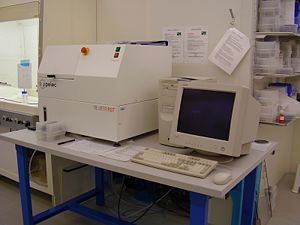Specific Process Knowledge/Thermal Process/Jipelec RTP: Difference between revisions
No edit summary |
|||
| (16 intermediate revisions by 4 users not shown) | |||
| Line 1: | Line 1: | ||
'''Feedback to this page''': '''[mailto:labadviser@danchip.dtu.dk?Subject=Feed%20back%20from%20page%20http://labadviser.danchip.dtu.dk/index.php/Specific_Process_Knowledge/Thermal_Process/Jipelec_RTP click here]''' | |||
''This page is written by DTU Nanolab internal'' | |||
==<span style="color:Red">EXPIRED. The Jipelec RTP has has been removed from the cleanroom in March 2023. It has been replaced with the Jipelec RTP2 that can be used instead.</span>== | |||
[[Category: Equipment |Thermal Jipelec]] | |||
[[Category: Thermal process|Jipelec]] | |||
==Jipelec - Rapid Thermal Processing== | ==Jipelec - Rapid Thermal Processing== | ||
[[Image:RTP_oven.jpg|300x300px|thumb|Jipelec RTP: Positioned in cleanroom | [[Image:RTP_oven.jpg|300x300px|thumb|Jipelec RTP: Positioned in cleanroom A-4/ Photo: DTU Nanolab internal]] | ||
The Jipelec is a rapid thermal processing oven. It | The Jipelec is a rapid thermal processing (RTP) oven. It is be used for fast and well-controlled annealing or alloying of samples. It is possible to use either a thermocouple or a pyrometer to control the temperature (of the sample carrier). | ||
'''The user manual | |||
'''The user manual, technical information and contact information can be found in LabManager:''' | |||
'''[http://www.labmanager.danchip.dtu.dk/function.php?module=Machine&view=view&mach=164 Jipelec RTP]''' | '''[http://www.labmanager.danchip.dtu.dk/function.php?module=Machine&view=view&mach=164 Jipelec RTP]''' | ||
| Line 19: | Line 29: | ||
|style="background:LightGrey; color:black"|Process Temperature | |style="background:LightGrey; color:black"|Process Temperature | ||
|style="background:WhiteSmoke; color:black"| | |style="background:WhiteSmoke; color:black"| | ||
*0- | *0-1100 <sup>o</sup>C (only short time a the high temperatures - see the user manual) | ||
*Temperature ramp up to | *III-V materials only to 450 <sup>o</sup>C | ||
*Temperature ramp up to 50 <sup>o</sup>C/min | |||
|- | |- | ||
|style="background:LightGrey; color:black"|Process pressure | |style="background:LightGrey; color:black"|Process pressure | ||
|style="background:WhiteSmoke; color:black"| | |style="background:WhiteSmoke; color:black"| | ||
*1 atm | *1 atm | ||
* | *Vacuum | ||
|- | |- | ||
|style="background:LightGrey; color:black"| | |style="background:LightGrey; color:black"|Gases on the system | ||
|style="background:WhiteSmoke; color:black"| | |style="background:WhiteSmoke; color:black"| | ||
| Line 35: | Line 47: | ||
|style="background:LightGrey; color:black"|Batch size | |style="background:LightGrey; color:black"|Batch size | ||
|style="background:WhiteSmoke; color:black"| | |style="background:WhiteSmoke; color:black"| | ||
* | *One 50 mm or 100 mm wafer | ||
*Small samples | *Small samples (placed on a carbide carrier or a Si carrier wafer with 1 µm oxide on the back) | ||
|- | |- | ||
| style="background:LightGrey; color:black"|Substrate | | style="background:LightGrey; color:black"|Substrate materials allowed | ||
|style="background:WhiteSmoke; color:black"| | |style="background:WhiteSmoke; color:black"| | ||
A silicon carrier wafer with 1 µm oxide is | A carrier is always needed: For III-V materials and metals a carbide carrier is used, and for other samples a silicon carrier wafer with 1 µm oxide is used | ||
*Silicon | *Silicon | ||
*Silicon | *Silicon oxide | ||
*Silicon | *Silicon nitride | ||
* | *Fused silica/quartz | ||
*Polysilicon | *Polysilicon | ||
*III-V materials (on graphite carrier, max 450 <sup>o</sup>C) | |||
*III-V materials (on graphite carrier) | *Some metals - (on graphite carrier). Ask the Thin Film group for permission | ||
* | |||
|- | |- | ||
|} | |} | ||
Latest revision as of 12:58, 17 April 2023
Feedback to this page: click here
This page is written by DTU Nanolab internal
EXPIRED. The Jipelec RTP has has been removed from the cleanroom in March 2023. It has been replaced with the Jipelec RTP2 that can be used instead.
Jipelec - Rapid Thermal Processing

The Jipelec is a rapid thermal processing (RTP) oven. It is be used for fast and well-controlled annealing or alloying of samples. It is possible to use either a thermocouple or a pyrometer to control the temperature (of the sample carrier).
The user manual, technical information and contact information can be found in LabManager:
| Purpose | RTP annealing | |
|---|---|---|
| Process parameter range | Process Temperature |
|
| Process pressure |
| |
| Gases on the system |
| |
| Substrates | Batch size |
|
| Substrate materials allowed |
A carrier is always needed: For III-V materials and metals a carbide carrier is used, and for other samples a silicon carrier wafer with 1 µm oxide is used
|
